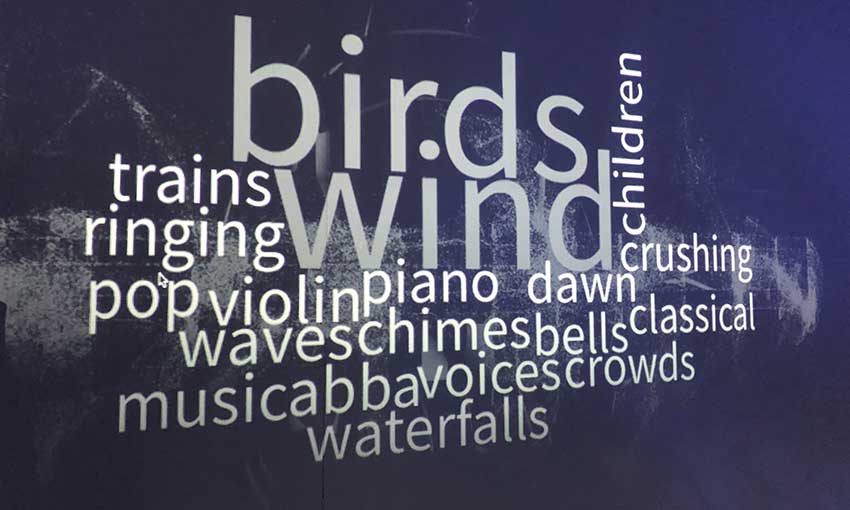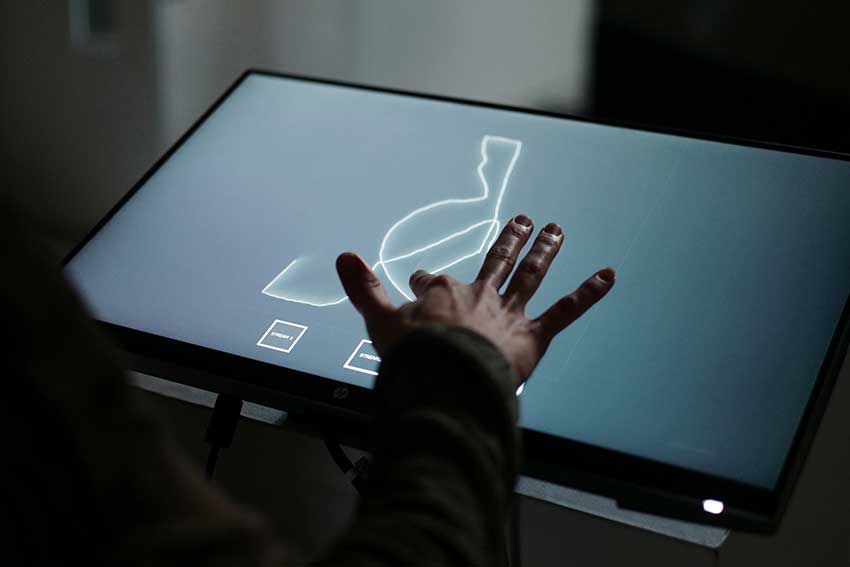Text by Laura Netz

KIMA was founded in 2010 as a collaborative project to enable a collaborative approach to creating performances and installations between artists, scientists, and researchers on the intersection of art, science and technology. Since then, they have collaborated with three core members – Evgenia Emets, Oliver Gingrich and Alain Renaud. Two years ago, the team was joined by David Negrao. Analema Group creates immersive experiences through which audiences learn about specific phenomena, usually related to our perception of sound, light and vision and the relationship between these.
The KIMA: Noise art installation promotes a practice which the group names as active listening, encouraging audiences to listen with ears but also to interact with hands, and eyes and experience sounds with the whole body. For Analema Group, active listening offers the possibility to ‘see’ sound, opening our ears and closing our eyes. According to Analema Group members, the art installation KIMA: Noise is where (…) we are exploring how sound affects our well-being. So, KIMA: Noise explores the effects of urban noise on citizens. Following, We are asking audiences, members of local communities and researchers about their experiences with urban noise and are encouraging them to come up with creative strategies and solutions to deal with urban noise daily as individuals and as communities.
Through KIMA: Noise, the context of the actual climate crisis is present. This work is about people being aware of the ecologies of sound in their life. The global warming crisis makes the practices of sound ecology criticize the anthropocentric climate regime where the unbalanced relations between human/non-humans are evident. Through these eco-sonic practices, artists reinforce the inclusive role of human in becoming biosphere (in terms of Rose Braidotti – becoming posthuman).
Another interesting aspect of KIMA: Noise is the audience participation in the creative process. In doing so, the installation appears central to the context of open democracy and participatory art. Moreover, Tate Exchange is a project that develops practices through communities and societies mediated through art practices. In this type of projects, art appears as a motor of society because engaging citizens through art practice contributes to a healthy and balanced community. Furthermore, these contributing practices promote socially engaged participation with other agents – communities, citizens, politicians, activists, etc. In this regime, art becomes a proactive agent in constructing society, and as Analema Group mentions (…) it is about people being in control, feeling empowered. The politics of empowering connect with the context of postfeminist and the transgression of political and patriarchal powers.

Can you explain what the installation consists of? Which technologies does the installation use?
The art installation KIMA: Noise consists of several immersive environments where the audience can experience noise on different levels. In the main space of Tate Exchange we can draw the trajectories of sound on a touch screen, and these ‘graphic scores’ will be translated into a spatial sound experience: the geometries of drawings will transform into the movement of sound across the space.
Facing the ‘Shard’, a visual installation will transform real-time sounds from four sources captured in four different locations outside of Tate Modern and augment them into a projection piece. Here we are exploring how sound affects our well-being – noises are interfering with urban representations, affecting its environment with intensity, attack and amplitude of sounds.
In a separate space, the audience can ‘feel’ the lower frequencies contained in urban noise through their bodies through an array of subwoofers, contrasted by silence. On top of the main installation, we are inviting the audience to contribute with their understanding of sound through an interactive word-cloud that they can contribute to. Visitors can send us a couple of words describing their experience of ‘urban noise’ and participate in this projection piece.
How does KIMA: Noise explore the effects of urban noise on citizens?
KIMA: Noise explores the effect of noise on citizens in several ways. We are asking audiences, members of local communities and researchers about their experiences with urban noise. We are encouraging them to develop creative strategies and solutions to deal with urban noise daily as individuals and as communities.
First and foremost, we invite everyone to become more aware of the noise by becoming more attentive to it and singling out separate noise events from the general ‘white noise’, the hum of the city. Then, we invite everyone to think about what noise means for us as beings, whether we are comfortable with it or even enjoying it, as in large metropolitan areas, noise is a constant and inseparable part of our lives. And also think together what are simple ways we can deal with noise, how we can rethink our relationship with it, how we can make this relationship active and meaningful.
We are doing all of this through our art installation, and various techniques of engagement, but also through talks and a workshop with communities. We are also interviewing scientists about their research and various projects and making this knowledge visible through our installation and a publication of a book which we are preparing for the Tate Exchange event.
You are encouraging the audience to participate in the installation. Can you explain what active listening is?
We are encouraging audiences to listen with their ears but also to interact with their hands, eyes and experience sounds with their whole body. Sound not only enters through our ears, whether we are aware of it or not, but it also affects us, positively or negatively, in many different ways. We have been fascinated for many years by the possibility of ‘see’ sound, for example, to perceive sound while it is being transformed into a visual realm. What it does to us is to raise awareness about sound and our perception of it.
Active listening includes a great deal of openness and attention. Of course, it relates to opening our ears more, which sometimes means closing our eyes. However, in the case of KIMA: Noise as with our other projects, it also means opening other senses and perceiving sound through its various expressions and means.






